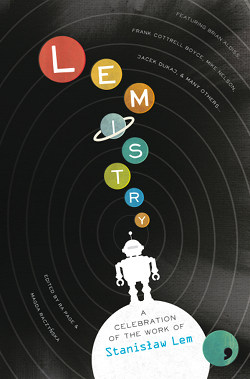Lemistry

Title: Lemistry. A Celebration of the Work of Stanislaw Lem
Edited by: Ra Page & Magda Raczyńska
Publisher: Comma Press
Published: 2011
Pages: 292
ISBN: 978 1905583324
Price: 7.99 £
We ‘know’ Stanislaw Lem, whether or not we consciously know that we do.
He may only be recognised in the West as the author of the twice-filmed novel, Solaris, but the influence of his other work is legion. From computer games (The Sims was inspired by one of his short stories), to films (the red and blue pills of The Matrix owe much to his Futurological Congress); from the space comedies of Red Dwarf to the metaphysical satires of Douglas Adams… the presence of this masterly Polish writer can be traced far and wide. Nor was his genius confined to fiction. Lem’s essays and pseudo-essays – borne out of the military industrial tensions of the Cold War – have outlived their original context and speak to the most current developments in virtual reality, nanotechnology, and artificial intelligence.
To celebrate his name, as well as his vision, this anthology brings together writers, critics and scientists who continue to grapple with his concerns. British and Polish novelists join screenwriters, poets, computer engineers, and artists, to celebrate and explore Lem’s legacy through short stories and essays - two literary forms that, as Lem knew well, can blend together to create something altogether new.
Stanislaw Lem - Who He?
Andy Sawyer
[...] Much of Lem’s own fiction has that rather overwritten style. The science fiction spaceships and robots are there, and there for a purpose – they mean something rather than being simply banged in for the goshwow factor – but the meat of the story is elsewhere. With Dick, it was often the uneasy tension between order and chaos, the real and the unreal. In Lem, science fiction is a way of exaggerating and mocking human idiocy, but there is also a love of the grotesque, of imagistic and linguistic excess, which makes him a master of the baroque. The descriptions of the ‘mimoids’ in Solaris or the picture of robots with medieval feudal societies in the Cyberiad are perfect examples. If ever there was a writer of the ‘wide-screen baroque’ it was Lem, but he was also a writer who (perhaps unlike Dick in his more unfortunate moments) avoided kitsch – that glamorous and ornate but essentially tasteless and derivative version of the baroque that feeds off art rather than creates it. Not understanding Polish, I can have no idea how the linguistic virtuosity of passages in The Cyberiad work in the original, but Michael Kandel (the translator of this and many others of Lem’s books, though not Solaris) is frequently praised, and they work well in the English, apart from Klapacius’s ‘zits’, without which life loses all its charm. But we will come to them later.
| Introduction | VII |
| ORIGINALS |
|
|
THE LILO |
1 |
|
DARKNESS AND MILDEW |
15 |
| INVASION FROM ALDERBARAN Stanisław Lem, Translated by Antonia Lloyd-Jones |
39 |


